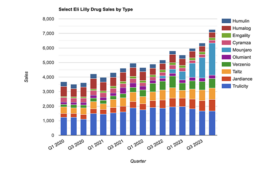
Eli Lilly and Company will present key primary and secondary endpoint data for lasmiditan, an investigational, oral, first-in-class molecule for the acute treatment of migraine, which demonstrated statistically significant improvements compared to placebo in the Phase 3 SPARTAN study. Detailed results will be highlighted today at the 18th Congress of the International Headache Society (IHC) in Vancouver.
“The data presented today demonstrate lasmiditan’s potential to reduce pain and provide freedom from the most bothersome symptoms associated with migraine,” said Christi Shaw, president of Lilly Bio-Medicines. “These results reflect Lilly’s 25-year commitment to migraine research and to bringing first-in-class advancements to patients, including the use of a new clinical endpoint evaluating a patient’s self-identified most bothersome symptom.”
These findings are consistent with SAMURAI, the first pivotal Phase 3 study evaluating the safety and efficacy of lasmiditan for the acute treatment of migraine. The most commonly-reported adverse events after lasmiditan dosing were dizziness, paresthesia, somnolence, fatigue, nausea and lethargy.
Lilly plans to submit a New Drug Application for lasmiditan to the U.S. Food and Drug Administration (FDA) in the second half of 2018.
SPARTAN Study Results
At two hours following the first dose, a greater percentage of patients treated with lasmiditan were migraine pain-free compared to placebo. These results were statistically significant across all three studied doses (50 mg, 100 mg and 200 mg). A statistically significantly greater percentage of patients were also free of their most bothersome symptom (MBS) compared with placebo at two hours. In this study, patients chose their MBS from nausea, sensitivity to sound or sensitivity to light.
The majority of patients treated with lasmiditan also experienced relief from migraine pain—classified as mild or no pain—at two hours following the first dose (59 percent for 50 mg, 64.8 percent for 100 mg and 65 percent for 200 mg, p < 0.001 for all dosing groups). These results were statistically significant compared to placebo (47.7 percent).
In this study, fewer patients treated with lasmiditan took a second, rescue dose of treatment compared to placebo (41 percent for 50 mg; 32.7 percent for 100 mg; 26.4 percent for 200 mg and 49.8 percent for placebo).
Lilly will submit the results to a peer-reviewed journal within the next year. An open-label Phase 3 study—GLADIATOR—is also underway evaluating the long-term safety of lasmiditan for the acute treatment of migraine.
About the SPARTAN Study
SPARTAN is a Phase 3 randomized, double-blind, placebo-controlled global trial evaluating the safety and efficacy of three doses of lasmiditan administered orally (50 mg, 100 mg or 200 mg) compared with placebo for the acute treatment of migraine. To be eligible for this trial, patients were required to have at least moderate migraine disability (as measured by a Migraine Disability Assessment Score (MIDAS) ≥ 11). Patients that participated in the trial had an average of more than five migraine attacks per month at baseline. SPARTAN did not exclude patients with one or more cardiovascular risk factors or known coronary artery disease. The primary endpoint of the study was comparison of the percentage of patients in the lasmiditan 200 mg and placebo groups who were migraine pain-free at two hours following the first dose. A key secondary endpoint of the study was comparison of the percentage of patients in each dosing group (200 mg, 100 mg and 50 mg) and placebo groups who were free of their MBS at two hours following the first dose. In these studies, MBS identified by patients included nausea, sensitivity to sound or sensitivity to light.
Filed Under: Drug Discovery




